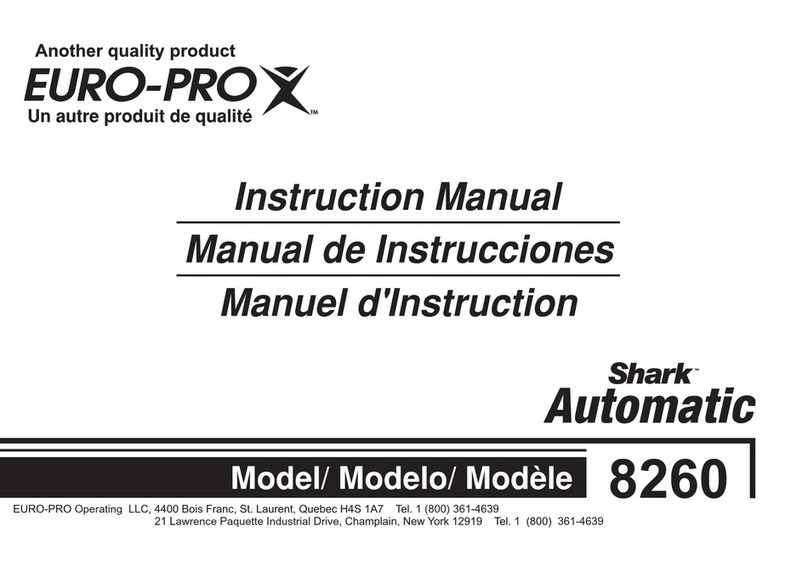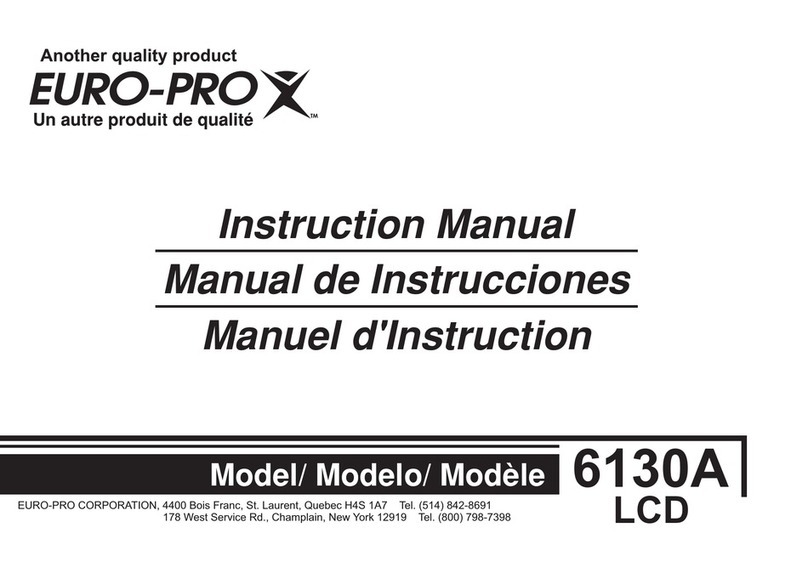EUROPRO 9120 User manual

INSTRUCTION MANUAL
MANUAL DE INSTRUCCIONES
9120
Draft 4 2003/8/12

INSTRUCTION MANUAL
This sewing machine is intended for household use.
IMPORTANT SAFETY
INSTRUCTIONS
When using a sewing machine, basic safety precautions should
always be followed, including the following.
Read all instructions before using.
DANGER - To reduce the risk of electric shock:
Never leave unattended when plugged in. Always unplug this
machine from the electric outlet immediately after using and before
cleaning.
WARNING- To reduce the risk of burns, fire,
electric shock, or injury to persons:
1.Do not allow to be used as a toy. Close attention is necessary
when this sewing machine is used by or near children.
2.Use this sewing machine only for its intended use as described in
this manual. Use only attachments recommended by the
manufacturer as contained in this manual.
3.Never operate this sewing machine if it has a damaged cord or
plug, if it is not working properly, if it has been dropped or
damaged, or dropped into water. Return the sewing machine to
the nearest authorized dealer or service center for examination,
repair, electrical or mechanical adjustment.
4.Never operate the sewing machine with any air openings
blocked. Keep ventilation openings of the sewing machine and
foot controller free from the accumulation of lint, dust, and loose
cloth.
5.Never drop or insert any object into any opening.
6.Do not use out doors.
7.Do not operate where aerosol (spray) products are being used or
where oxygen is being administered.
8.To disconnect, turn the power switch to the off position (symbol
O), then remove plug from outlet.
9.Do not unplug by pulling on cord. To unplug, grasp the plug, not
the cord.
10.Keep fingers away from all moving parts. Special care is required
around the sewing machine needle.
11.Always use the proper needle plate. The wrong plate can cause
the needle to break.
12.Do not use bent needles.
13.Do not pull or push fabric while stitching. It may deflect the
needle causing it to break.
14.Switch the sewing machine off (symbol O) when making any
adjustments in the needle area, such as threading needle,
changing needle, threading bobbin, or changing presser foot.
15.Always unplug sewing machine from the electrical outlet when
removing covers, lubricating, or when making any other user
servicing adjustments mentioned in the instruction manual.
16.Handle the foot controller with care and avoid dropping it on the
floor. Be sure not to place anything on top of it.
17.Use only the handle to lift and move the machine.
18.Do not expose the machine or machine plastic case to sunlight
directly. Also, do not keep it in a very warm or damp place.
SAVE THESE INSTRUCTIONS
Servcing should be performed by an authorized service
representative.
MANUAL DE INSTRUCCIONES
Esta máquina de coser está diseñada sólo para uso doméstico.
INSTRUCCIONES
IMPORTANTES DE SEGURIDAD
Al usar una máquina de coser siempre se deben tomar
precauciones básicas de seguridad, incluyendo las siguientes:
Lea todas las instrucciones antes de usar la máquina de coser.
PELIGRO: Para reducir el riesgo de choque
eléctrico:
No deje la máquina de coser desatendida cuando esté enchufada.
Siempre desenchúfela del tomacorriente inmediatamente después
de usarla o antes de limpiarla.
ADVERTENCIA: Para reducir el riesgo de
quemaduras, incendio, choque eléctrico o lesiones
personales:
1.No permita que se use como juguete. Se debe supervisar
estrechamente a los niños cuando usen la máquina de coser o
se use cerca de ellos.
2.Use la máquina de coser sólo para lo que está diseñada y para
lo que está descrito en este manual. Sólo use los accesorios
recomendados por el fabricante en este manual.
3.Nunca opere la máquina de coser si tiene el cordón o el enchufe
dañado, después que hubiese funcionado mal, que se hubiese
caído, dañado de cualquier forma o caído en agua. Dev uélvala
al distribuidor o servicentro autorizado para su revisión,
reparación o ajuste eléctrico o mecánico.
4.Nunca opere la máquina de coser si alguna de sus aberturas
para aire está obstruida. Mantenga las aberturas de ventilación y
el control de pie sin acumulaciones de pelusa, polvo y sin telas
sueltas.
5.Nunca inserte o deje caer objeto alguno en las aberturas.
6.No usar en exteriores.
7.No opere en ambientes donde se estén usando aerosoles o
donde se esté administrando ox ígeno.
8.Para desconectar, primero apague la máquina con su interruptor
(O) y después desenchúfela del tomacorriente.
9.No desconecte del tomacorriente jalando del cordón, hacerlo
jalando del enchufe.
10.Mantenga los dedos alejados de las piezas móviles. Tenga
cuidado especial alrededor de la aguja de coser.
11.Siempre use la placa adecuada para la aguja. La placa
equivocada puede hacer que la aguja se rompa.
12.No use agujas dobladas.
13.No empuje ni jale la tela mientras la máquina esté dando
puntadas porque la aguja puede doblarse y romperse.
14.Apague la máquina de coser con su interruptor (O) antes de
hacer cualquier ajuste alrededor de la aguja, como enhebrar o
cambiar la aguja, cambiar el carrete, enrollar la bobina, cambiar
la pata prensora, etc.
15.Siempre desenchufe la máquina de coser del tomacorriente
antes de quitarle las cubiertas, lubricarla o hacerle cualquier otro
servicio o ajuste mencionado en este manual.
16.Manipule el pedal controlador cuidadosamente y evite dejarlo
caer en el piso. Cerciórese de no colocarle cosa alguna encima.
17.Para levantar o mover la máquina, hacerlo sólo del asa.
18.No exponga la máquina o su estuche plástico a la luz solar
directa. Tampoco las mantenga en lugares calientes y húmedos.
CONSERVE ESTAS
INSTRUCCIONES
El servicio debe hacerlo un representante autorizado de servicio.

1
CONTENTS
MAIN PARTS ...................................................... 2
ACCESSORIES .................................................. 3
DUST COVER .................................................... 3
EXTENSION TABLE ........................................... 4
a. REMOVING THE EXTENSION TABLE .............................. 4
b. OPENING THE ACCESSORY CASE ................................ 4
CHANGING THE PRESSER FOOT ................... 4
A. Changing the presser foot .................................................. 4
B. Removing the presser foot holder ...................................... 4
INSERTING THE NEEDLE ................................. 5
FABRIC, THREAD AND NEEDLE TABLE .......... 5
CONNECTING THE MACHINE .......................... 6
FOOT CONTROLLER ........................................ 6
FUNCTION OF EACH PART .............................. 7
A. START/STOP BUTTON ..................................................... 7
B. REVERSE STITCH BUTTON ............................................. 7
C. SLOW BUTTON ................................................................. 7
D. SPEED CONTROL BUTTON ............................................. 7
E. NEEDLE UP/DOWN BUTTON ........................................... 7
F. PRESSER FOOT LIFTER .................................................. 7
G. DROP FEED LEVER .......................................................... 7
H. TOP COVER ...................................................................... 7
I. HAND WHEEL .................................................................... 7
TO SELECT A UTILITY PATTERN .................... 8
A. CONTRAST OF THE L.C.D................................................ 8
B. UTILITY BUTTONS ............................................................ 8
C. TO SELECT A UTILITY STITCH PATTERN ...................... 8
D.
INFORMATIONS OF SELECTED PATTERN ...............................
9
a.Stitch Pattern ........................................................................ 9
b.Pattern Numer ...................................................................... 9
c.Suitable Presser Foot ........................................................... 9
d.Stitch Width ........................................................................... 9
e.Stitch Length ......................................................................... 9
f. Setting of Auto-tack stitch ..................................................... 9
BOBBIN SETTING ............................................ 10
A. REMOVING THE BOBBIN ............................................... 10
B. SETTING SPOOL OF THREAD ON SPOOL PIN ............ 10
C. WINDING THE BOBBIN ................................................... 10
D. INSERTING THE BOBBIN ............................................... 11
THREADING THE MACHINE ........................... 12
A. PREPARING TO THREAD MACHINE ............................. 12
B. SETTING SPOOL OF THREAD ON SPOOL PIN ............ 12
C. THREADING THE UPPER THREAD ............................... 12
D. THREADING THE NEEDLE EYE ..................................... 13
E. DRAWING UP THE BOBBIN THREAD ............................ 13
STARTING TO SEW ......................................... 14
A. START AND END OF SEAM............................................ 14
B. REVERSE STITCHING .................................................... 14
C. TURNING CORNERS ...................................................... 15
D. SEWING HEAVY FABRIC ................................................ 15
E. SEWING OVER OVERLAPPED AREAS ......................... 15
F. WIDTH OF SEAM ALLOWANCE ..................................... 15
ADJUSTING THE THREAD TENSIONS .......... 16
A. Correct Thread Tensions .................................................. 16
B. When bobbin thread appears on top side of fabric. .......... 16
C. When upper thread appears on the bottom side of fabric. 16
D. Thread Tension for Zigzag Stitches .................................. 16
Helpful Hint ............................................................................ 16
STRAIGHT STITCH SEWING .......................... 17
A. Straight Stitch ................................................................... 17
B. Straight Stitch With Auto-reverse Stitch ........................... 17
ZIGZAG STITCH SEWING ............................... 18
SATIN STITCHING (No. 8) .................................................... 18
MULTI-STITCH ZIGZAG ................................... 18
A. Elastic Band Sewing ......................................................... 18
B. Overcast Stitching ............................................................ 18
ELASTIC STITCH SEWING ............................. 19
FREE ARM SEWING ........................................ 19
OVERCASTING-OVERLOCKING .................... 20
A. USING THE OVERCASTING FOOT ................................ 20
B. USING THE REGULAR FOOT ......................................... 20
C. NOTE: ............................................................................... 20
BLIND HEM STITCHING .................................. 21
BUTTONHOLE SEWING .................................. 22
A. WHEN SEWING STRETCH FABRIC ............................... 23
SEWING ON BUTTONS ................................... 24
A. Thread Shank ................................................................... 24
AUTOMATIC BAR-TACK .................................. 25
PATCH WORK .................................................. 25
INSERTING ZIPPERS
CENTERED INSERTION .................................. 26
LAPPED INSERTION ....................................... 27
A.
TO OPEN THE ZIPPER WHILE STITCHING ............................
27
APPLIQUE ........................................................ 28
a. When sewing sharp angles .............................................. 28
SCALLOP STITCH ........................................... 28
a. SCALLOP HEM (No. 26) .................................................. 28
b. SCALLOP EDGING (No. 27) ............................................ 28
QUILTING ..................................................................29
A. Joining the pieces of fabric .......................................................... 29
B. Quilting ........................................................................................ 29
C. Hand Look Quilting Stitch (No. 6) ................................................ 29
GATHERING .............................................................. 29
NARROW HEMMING ................................................ 30
CORDING ..................................................................30
A. SINGLE CORDING ..................................................................... 30
B. TRIPLE CORDING ...................................................................... 30
DARNING/FREE-HAND EMBROIDERY ................... 31
A. ATTACHING THE DARNING/EMBROIDERY FOOT .................. 31
B. DARNING .................................................................................... 31
C. FREE-HAND EMBROIDERY ...................................................... 31
DECORATIVE AND LETTER STITCH SEWING ......
32
A. DECORATIVE AND LETTER STITCH BUTTONS ........... 32
B. TO SELECT DECORATIVE AND LETTER STITCH
PATTERN .............................................................................. 32
C. TO CHECK SELECTED PATTERNS ............................... 33
D.
ADJUSTING STITCH WIDTH AND LENGTH ............................
33
E. TO DELETE SELECTED PATTERN ................................ 33
F. TO SEW SELECTED PATTERNS ................................... 34
G. TIPS .................................................................................. 34
a. To sew selected patterns from beginning. ........................ 34
b. To recall selected patterns ................................................ 34
MAINTENANCE ................................................ 35
CLEANING ........................................................ 35
A. Bobbin Holder ................................................................... 35
B. Hook Race and Feed Dog ................................................ 35
HELPFUL HINT ................................................ 36
PATTERN CHART ............................................ 37
CONTENIDO
PARTES PRINCIPALES ..................................... 2
ACCESORIOS .................................................... 3
TAPA DE LA MÁQUINA ..................................... 3
MESA EXTENSIBLE ........................................... 4
a. DESMONTAJE DE LA MESA EXTENDIBLE ..................... 4
b. ABERTURA DEL ESTUCHE DE ACCESORIOS ............... 4
CAMBIO DE PATA PRENSORA ........................ 4
A. Cambio de la pata prensora ............................................... 4
B. Extracción del portapata ..................................................... 4
INSERCIÓN DE LA AGUJA ................................ 5
CARTILLA GUÍA PARA HILO Y AGUJA SEGÚN
LA TELA .......................................................... 5
CONEXIÓN DE LA MÁQUINA ............................ 6
PEDAL CONTROLADOR ................................... 6
FUNCIONES DE LOS COMPONENTES ........... 7
A. BOTÓN DE ENCENDIDO .................................................. 7
B. BOTÓN PARA PUNTADA INVERSA ................................. 7
C. BOTÓN PARA COSTURA LENTA ..................................... 7
D. BOTÓN PARA CONTROL DE VELOCIDAD ...................... 7
E. BOTÓN PARA SUBIR Y BAJAR LA AGUJA ...................... 7
F. LEVANTADOR DE LA PATA PRENSORA ........................ 7
G. PALANCA PARA BAJAR EL MECANISMO DE
ALIMENTACIÓN DE LA TELA ................................................ 7
H. CUBIERTA SUPERIOR ...................................................... 7
I. MANIVELA ......................................................................... 7
PARA SELECCIONAR UN PATRÓN DE
COSTURA ....................................................... 8
A. Contraste de la Pantalla Digital .......................................... 8
B. Botones Selectores de Patrones ........................................ 8
C. Selección del Patrón de Costura ........................................ 8
D. Información del Patrón Seleccionado ................................. 9
a. El Patrón de Puntada ......................................................... 9
b. El Número que identifica el patrón ..................................... 9
c. Tipo de pata prensora que debe usarse. ............................ 9
d. Ancho de la Puntada .......................................................... 9
e. Largo de la Puntada ........................................................... 9
f. Configuración del Hilván Automático .................................. 9
ARMADO DE LA BOBINA ................................ 10
A. Extracción de la Bobina .................................................... 10
B. Colocación del Carrete de Hilo en su Eje ......................... 10
C. ENROLLADO DEL HILO EN LA BOBINA ........................ 10
D. Inserción de la Bobina ...................................................... 11
ENHEBRADO DE LA MÁQUINA ...................... 12
A. Preparación para Enhebrar la Máquina ............................ 12
B. Colocación del Carrete de Hilo en el Eje .......................... 12
C. Enhebrado del Hilo Superior ............................................ 12
D. ENSARTADO DEL HILO EN LA AGUJA ......................... 13
E. TEMPLADO DEL HILO DE LA BOBINA........................... 13
PARA COMENZAR A COSER ......................... 14
A. Comienzo de un Extremo de una Costura ....................... 14
B. Puntada Inversa ............................................................... 14
C. CAMBIO DE DIRECCIÓN DE LA COSTURA .................. 15
D. COSTURA DE TELAS GRUESAS ................................... 15
E. COSTURA DE TELAS TRASLAPADAS........................... 15
F. TOLERANCIA PARA EL ANCHO DE LA COSTURA ....... 15
REGULACIÓN DE LA TENSIÓN DE LOS
HILOS ........................................................... 16
A. Tensión correcta de los hilos ............................................ 16
B. Cuando el hilo de la bobina aparece en el lado superior de la
tela. ........................................................................................ 16
C.
Cuando el hilo superior aparece en la parte inferior de la tela ...
16
D. Tensión del hilo para puntadas zigzag ............................. 16
CONSEJO PRÁCTICO ..................................... 16
COSTURA CON PUNTADA RECTA ................ 17
A. Puntada Recta .................................................................. 17
B. Puntada Recta con Puntada Inversa Automática ............. 17
COSTURA ZIGZAG .......................................... 18
PUNTADA SATÉN (No. 8) ................................ 18
ZIGZAG DE PUNTADA MÚLTIPLE .................. 18
A. Costura de Bandas Elásticas ........................................... 18
B. Puntada Ribeteadora ........................................................ 18
COSTURA CON PUNTADAS ELÁSTICAS ...... 19
MESA EXTENSIBLE ......................................... 19
COSTURA CON PUNTADA RIBETEADORA .. 20
A. Usando la Pata Ribeteadora ............................................ 20
B. Uso de la Pata Estándar ................................................... 20
C. NOTA: ............................................................................... 20
PUNTADA ELÁSTICA INVISIBLE .................... 21
COSTURA DE OJALES .................................... 22
A. Costura de Telas Elásticas ............................................... 23
COSTURA DE BOTONES ................................ 24
A. Vástago de Hilo para el Botón. ......................................... 24
COSTURA AUTOMÁTICA DE REFUERZOS ... 25
COSTURA DE PARCHES ................................ 25
COSTURA CENTRADA DE CREMALLERAS .. 26
COSTURA TRASLAPADA DE CREMALLERAS27
A. Abertura de la Cremallera Mientras se Cose ................... 27
APLICACIONES ............................................... 28
a. Al coser ángulos pronunciados ........................................ 28
PUNTADA FESTÓN ......................................... 28
a. Costura Festón (No. 26) ................................................... 28
b. Acabado con Costura Festón (No. 27) ............................. 28
COSTURA DE COLCHAS ................................ 29
A. Unión de las tres piezas de tela ....................................... 29
B. Acolchado ......................................................................... 29
C. Puntada con apariencia manual para colchas (No. 6) ...... 29
RECOGIDOS .................................................... 29
DOBLADILLOS ANGOSTOS30
COSTURA DE CORDONES ............................. 30
A. Un solo cordón ................................................................. 30
B. Cordón Triple .................................................................... 30
ZURCIDO Y BORDADO A MANO LIBRE ........ 31
A. Instalación de la pata para zurcir y bordar. ...................... 31
B. Zurcido .............................................................................. 31
C. Bordado a Mano Libre ...................................................... 31
D. Después de Terminar de Zurcir o Bordar. ........................ 31
COSTURA DECORATIVA Y MONOGRAMAS . 32
A. Costura Decorativa y Monogramas .................................. 32
B. Selección del Patrón de Puntadas Decorativas y
Monogramas .......................................................................... 32
C. Revisión de los Patrones Seleccionados ......................... 33
D. Regulación del Ancho y Largo de la Puntada .................. 33
E. Para Borrar el Patrón Seleccionado ................................. 33
F. Costura de los Patrones Seleccionados ............................ 34
G. CONSEJOS PRÁCTICOS ................................................ 34
a. Para coser los patrones seleccionados desde el principio 34
b. Para ver los patrones seleccionados ................................ 34
MANTENIMIENTO ............................................ 35
LIMPIEZA .......................................................... 35
A. Portabobina ...................................................................... 35
B. Pista de la Lanzadera y Mecanismo de Avance de la Tela35
DIAGNÓSTICO DE PROBLEMAS ................... 36

2
MAIN PARTS
1. Light Cover
2. Needle Up/Down Button
3. Speed Control Button
4. Slow Button
5. Reverse Button
6. Start/Stop Button
7. Extension Table
8. Top Cover
9. Hand Wheel
10.Control Panel
11.Thread Cutter
12.Buttonhole Lever
13.Needle Threader
14.Needle Threader Lever
15.Presser Foot Thumb Screw
16.Presser Foot Holder
17.Presser Foot
18.Fabric Feed Dogs
19.Needle Plate
20.Needle Clamp Screw
21.Needle Bar Thread Guide
22.Needle
23.Bobbin Cover
24.Bobbin Cover Latch
25.Thread Take-Up Lever (Inside)
26.Thread Tension Regulator
27.Thread Guide Plate
28.Spool Pin
29.Spool Cap
30.Bobbin Winder Thread Guide
31.Felt Washer
32.L. C. D. Contrast Control
33.Bobbin Winder Shaft
34.Bobbin Winder Stop
35.Liquid Crystal Display (L. C. D.)
36.Function Buttons (x5)
37.Utility Stitch Buttons (x5)
38.Decorative Stitch Button
39.Letter Stitch Buttons (x2)
40.Scroll Buttons
41.Clear Button
42.Read Button
43.Presser Foot Lifter
44.Drop Feed Lever
45.Power Line Cord
46.Foot Controller
47.Handle
48.Power Switch
49.Terminal Box
50.Controller Jack
1
2
3
8
4
5
6
7
9
10
11
12
13
14
15
16
17
18
19
20
21
22
23
24
25 26 27 28 29 30 31 32 33
35
36
37
38
39
40
41
42
43
45
46
47
48
49
50
34
44
PARTES PRINCIPALES
1. Cubierta de la Luz
2. Botón para Subir y Bajar la Aguja
3. Botón de Control de Velocidad
4. Botón de Costura Lenta
5. Botón de Costura Inversa
6. Interruptor
7. Mesa Extensible
8. Cubierta Superior
9. Manivela
10.Panel de Control
11.Cortador de Hilo
12.Palanca para Ojales
13.Enhebrador de Hilo
14.Palanca del Enhebrador de Hilo
15.Perilla para Pata Prens ora
16.Sujetador de la Pata Prensora
17.Pata Prensora
18.Mecanismo Alimentador de Tela
19.Placa de la Aguja
20.Perilla del Porta Aguja
21.Guía del Hilo del Vástago del Porta Aguja
22.Aguja
23.Tapa de la Bobina
24.Pestillo de la Tapa de la Bobina
25.Palanca Tensora del Hilo (Interior)
26.Regulador de Tensión del Hilo
27.Placa Guía del Hilo
28.Eje para el Carrete del Hilo
29.Tapa para el Carrete del Hilo
30.Guía para Enrollar el Hilo en la Bobina
31.Arandela de Fieltro
32.Regulador de Contraste del Visualizador
33.Eje Enrollador de la Bobina
34.Tope del Enrollador de la Bobina
35.Pantalla Visora Digital de Cuarzo Líquido
36.Botones de Funciones (x5)
37.Botones para Puntadas (x4)
38.Botón para Puntada Decorativa
39.Botones para Monogramas (x2)
40.Botones Visualizadores
41.Botón para Despejar
42.Botón para Leer
43.Palanca Levantadora de la Pata
Prensora
44.Palanca del Mecanismo Alimentador de
Tela
45.Cordón de Suministro Eléctrico
46.Pedal Controlador
47.Asa
48.Interruptor
49.Caja Terminal
50.Enchufe para el Controlador

3
ACCESSORIES
Accessories are provided in the accessory
case.
(See next page, [EXTENSION TABLE])
1. Needle Pack (#11, #14, #16, Needle for
knit and synthetic fabric #11, #14)
2. 4 Bobbins ( 1 is in the machine)
3. Seam Ripper
4. Screw Driver
5. Thread Cap (On the machine when
delivered)
6. Satin Foot (B)
7. Overcasting Foot (C)
8. Zipper Foot (E)
9. Button Sewing Foot
10. Straight Stitch / Quilting Foot
11. Quilting Bar
12. Narrow Hemming Foot
13. Cording Foot
14. Gathering Foot
15. Darning Embroidery Foot
16. Blind Foot (D)
17. Buttonhole Foot (F)
18. Regular Foot (A) (On machine when
delivered)
1234
56
8910
DUST COVER
Cover the machine with dust cover
when it is not to be used.
7
12 13 14
15 16
17 18
11
ACCESORIOS
Los accesorios se proveen en el estuche de
accesorios.
(Ver la siguiente página para la mesa
extensible)
1. Paquete de agujas (No. 11, 14, 16 y para
Telas Tejidas y Sintéticas No. 11 y 14).
2. 4 bobinas (1 instalada)
3. Cortador de Costuras
4. Entornillador
5. Tapa para Carrete de Hilo (Instalada)
6. Pata para Puntada Satén (B)
7. Pata para Ribetear (C)
8. Pata para Cremalleras (E)
9. Pata para Coser Botones
10. Pata para Puntada Recta y Colchas
11. Guia de Acolchar
12. Pata para Dobladillos Angostos
13. Pata para Cordones
14. Pata para Recogidos
15. Pata para Zurcidos y Bordados
16. Pata para Puntada Invisible (D)
17. Pata para Ojales (F)
18. Pata Estándar (A) (Instalada)
TAPA DE LA MÁQUINA
Cubre la máquina para protegerla contra el
polvo cuando no está en uso.

4
EXTENSION TABLE
a. REMOVING THE EXTENSION TABLE
Hook your finger to the left bottom side of
extension table and slide it to the left. To
attach, insert to the right.
b. OPENING THE ACCESSORY CASE
Hook your finger to the this side of
accessory case and pull toward you.
CHANGING THE PRESSER
FOOT
The presser foot must be changed according
to the stitch you sew, or work you do.
CAUTION: To prevent accidents.
Turn off the power switch before you change
the presser foot.
A. Changing the presser foot
1. Turn the hand wheel toward you until the
needle is at its highest point.
2. Raise the presser foot lifter.
3. Remove the presser foot by pushing the
presser foot release lever toward you.
4. Place desired foot with its pin directly
under the slot in presser foot holder.
5. Lower the presser foot lifting lever and the
presser foot will snap into place.
B. Removing the presser foot holder
When cleaning around the feed dog or
attaching extra foot (option), you may
remove the presser foot holder.
1. Remove the presser foot.
2. Loosen the presser foot thumb screw and
remove the presser foot holder.
3. To replace the holder, pull up the holder
as far as it will go from bottom of presser
bar.
4. Tighten the thumb screw.
MESA EXTENSIBLE
a. DESMONTAJE DE LA MESA
EXTENDIBLE
Enganche el dedo en el lado inferior
izquierdo de la mesa extendible y
deslícela a la izquierda. Para reinstalarla,
insértela y deslícela a la derecha.
b. ABERTURA DEL ESTUCHE DE
ACCESORIOS
Enganche el dedo en éste lado del
estuche de accesorios y jálelo hacia
usted.
CAMBIO DE PATA
PRENSORA
La pata prensora debe cambiarse de
acuerdo al tipo de puntada que se va a usar
para coser.
PRECAUCIÓN: Para evitar
accidentes,
corte el suministro de corriente a la máquina
antes de cambiar la pata prensora.
A. Cambio de la pata prensora
1. Gire la manivela hacia Usted Hasta que la
aguja quede en su posición más alta.
2. Levante la pata prensora con el
levantador.
3. Saque la pata prensora empujando la
palanca de zapata prensora hacia Usted
4. Coloque la pata prensora deseada con su
vástago directamente bajo la ranura del
porta pata.
5. Baje la palanca levantadora de la pata
prensora y ésta enganchará en posición.
B. Extracción del portapata
Cuando limpie alrededor del mecanismo
alimentador de tela o instale una pata
adicional (opcional), se puede sacar el porta
pata.
1. Saque la pata prensora.
2. Saque el portapata aflojando su perilla de
fijación.
3. Para reinstalar el porta pata, empujarlo
tan arriba como sea posible en el vástago
del porta pata.
4. Ajuste la perilla.

5
INSERTING THE NEEDLE
Select a needle of the right type and size for
the fabric to be sewn.
CAUTION: To prevent accidents.
Turn off the power before removing the
needle.
1. Turn the hand wheel toward you until the
needle is at its highest point.
2. Loosen the needle clamp screw.
3. Remove the needle.
4. Insert new needle into needle clamp with
the flat side to the back and push it up as
far as it will go.
5. Tighten the needle clamp screw.
FABRIC,THREAD AND NEEDLE TABLE
Select size of thread and needle in accordance with fabric to be sewn.
Type of Fabric
Light Weight - thin
georgette, organdy, voile,
taffeta, silk, etc.
Medium Weight - gingham,
pique, linen, cotton, satin,
thin corduroy, velvet
Heavy Weight - gabardine,
tweed, denim, corduroy
Stretch - double knit, tricot,
spandex, jersey
Thread Size
Ctn #80 - 100
Silk 60 - 80
Syn 80 - 100
Ctn 50 - 80
Silk 50
Syn 50 - 80
Ctn 40 - 50
Silk 50
Syn 50 - 60
Syn 50 - 80
Silk 50
Thread for knit
Needle Size
9/70-11/80
11/80-14/90
14/90-16/100
11/80-14/90
Needle for knit
and synthetic
fabric
Use a Home sewing machine needle.
a. Do not use the bent or blunt needle. Place
needle on a flat plate and check
straightness.
INSERCIÓN DE LA AGUJA
Seleccione la aguja del tipo y tamaño
adecuado para la tela que se va a coser.
PRECAUCIÓN: Para evitar
accidentes,
corte el suministro eléctrico antes de sacar la
aguja.
1. Gire la manivela hacia Usted hasta que la
aguja llegue a su posición más alta.
2. Afloje el tornillo sujetador de la aguja.
3. Saque la aguja.
4. Inserte la aguja nueva en el sujetador con
la parte plana hacia atrás y empújela
hacia arriba hasta el tope.
5. Vuelva a ajustar el tornillo sujetador de la
aguja.
a. No use agujas dobladas o sin punta.
Coloque la aguja sobre una placa plana y
verifique que esté recta.
CARTILLA GUÍA PARA HILO Y AGUJA
SEGÚN LA TELA
Seleccione el hilo y la aguja de acuerdo a la tela que se va a coser.
Tipo de Tela
Tela delgada: gasas de
algodón, sedas sintéticas,
georget, organdí, tafetán,
etc.
Tela Mediana: telas de
algodón, sintéticas, piqué,
popelinas, lino, algodón,
satén, corduroy delgado,
terciopelo
Telas Gruesas: gabardina,
tweed, denim, mezclilla,
corduroy
Telas estirables: de doble
punto, tricot, spandex,
jersey
Tamaño de Hilo
Algodón 80 a100
Seda 60 a 80
Sintético 80 a100
Algodón 50 A 80
Seda 50 A
Sintético 50 A 80
Algodón 40 A 50
Seda 50 A
Sintético 50 A 60
Algodón 50 a 80
Seda 50 a
Hilo para tejer
Tamaño de
Aguja
9/10 – 11/80
11/80 – 14/90
14/90 – 16/100
11/80 – 14/90
Aguja para telas
tejidas y
sintéticas
Use una aguja para máquinas de coser domésticas

6
CONNECTING THE
MACHINE
DANGER: To reduce the risk of
electric shock.
Never leave unattended when plugged in.
Always unplug this machine from the electric
outlet immediately after using and before
maintenance.
WARNING: To reduce the risk of
burns, fire, electric shock, or injury
to persons.
Do not unplug by pulling on cord. To unplug,
grasp the plug, not the cord.
1. Place machine on stable table.
2. Connect the power line cord to the
machine by inserting the 2-hole plug into
the terminal box.
3. Connect the power line plug to the electric
outlet.
4. Turn on the power switch.
5. A lamp will light up when switch is turned
on.
6. To disconnect, turn the power switch to
the off position (symbol O), then remove
plug from outlet.
FOOT CONTROLLER
Use of foot controller will permit control of
start, stop and speed with your foot.
1. Turn off the power switch. (symbol O)
2. Push foot controller plug into the jack on
machine.
3. Place foot controller at your feet.
4. Turn on the power switch.
5. A lamp will light up when switch is turned
on.
6. The harder you press the foot controller,
the faster the machine will sew. The
machine will stop when foot controller is
released.
WARNING: To reduce the risk of
burns, fire, electric shock, or injury
to persons.
1. Turn off the power when connecting the
foot controller to the machine.
2. Handle the foot controller with care and
avoid dropping it on the floor. Be sure not
to place anything on top of it.
3. Use only foot controller provided with this
machine. (Type 4C-337B)
POLARIZED PLUG INFORMATION
This appliance has a polarized plug (one blade wider than the
other). To reduce the risk of electric shock, this plug is intended to
fit in a polarized outlet only one way. If the plug does not fit fully in
the outlet, reverse the plug. If it still does not fit, contact a qualified
electrician to install the proper outlet. Do not modify the plug in any
way.
CONEXIÓN DE LA MÁQUINA
INFORMACIÓN REFERENTE AL ENCHUFE POLARIZADO
Este electrodoméstico está equipado con un enchufe polarizado
(note que una patita es más ancha que la otra). Para reducir el
riesgo de choques eléctricos, este enchufe solamente puede ser
usado en una toma de corriente polarizada. Si no puede insertar el
enchufe completamente en la toma de corriente, déle la vuelta e
inténtelo de nuevo. Si el enchufe no entra todavía correctamente,
contrate a un electricista cualificado para que le instale la toma de
corriente adecuada. No intente modificar el enchufe.
PEDAL CONTROLADOR
El uso del pedal controlador le permitirá
poner en marcha la máquina, detenerla y
regular la velocidad.
1. Encienda la máquina con su
interruptor.(O)
2. Inserte el conector en el enchufe de la
máquina.
3.
Ponga el pedal en el piso, debajo de su pie.
4. Encienda la máquina con su interruptor.
5. Una luz iluminará cuando la máquina esté
encendida.
6. Cuando más fuerte presione el pedal, más
rápido cocerá la máquina. La máquina se
detendrá cuando suelte el pedal.
ADVERTENCIA: Para reducir el riesgo
de quemaduras, incendios, choque
eléctrico o lesiones personales:
1. Corte el suministro eléctrico a la máquina
antes de conectar el pedal controlador a
la máquina.
2. Manipule el pedal controlador con
cuidado y evite dejarlo caer al piso.
Cerciorese de no colocar objeto alguno
encima.
3. Use el pedal suministrado con esta
máquina. (Tipo 4C-337B)
PELIGRO: Para reducir el riesgo de
choque eléctrico.
Nunca deje la máquina desatendida cuando
esté enchufada. Siempre desenchufe la
máquina del tomacorriente inmediatamente
después de usarla y antes de darle
mantenimiento.
ADVERTENCIA: Para reducir el riesgo
de quemaduras, incendios, choque
eléctrico o lesiones personales,
no desenchufe la máquina jalando del
cordón, hágalo agarrando del enchufe.
1. Coloque la máquina sobre una mesa
estable.
2. Conecte el enchufe hembra de 2 orificios,
al tomacorriente de la máquina.
3. Conecte el enchufe macho a un
tomacorriente en la pared.
4. Encienda la máquina con el interruptor.
5. Una luz indicadora se iluminará cuando la
máquina esté encendida.
6. Antes de desenchufar la máquina del
tomacorriente, apáguela con su
interruptor. (O)

7
H
I
FUNCTION OF EACH PART
A. START/STOP BUTTON
The machine will start running when start/
stop button is pressed and will stop when
pressed the second time. The machine will
rotate slowly at start of sewing.
Note: When the foot controller is connected,
start/stop button will be disactivated.
B. REVERSE STITCH BUTTON
The machine will continue to sew in reverse
at low speed while this button is pressed and
stop when this button is released.
Note:When the foot controller is connected,
machine will sew in reverse (at low speed)
while this button is pressed. When released,
machine will sew forward.
C. SLOW BUTTON
While sewing, by pressing this button,
machine will sew in slow speed. Pressing
this button again, the speed will return.
D. SPEED CONTROL BUTTON
The machine will sew faster when the button is slided to the right,
and sew slower when button is slided to the left.
Note: When the foot controller is connected, this button limit the
maximum speed.
E. NEEDLE UP/DOWN BUTTON
Needle stop position will be changed up or down by pressing this
button.
F. PRESSER FOOT LIFTER
The presser foot is lifed up or down by this lever.
Note: Machine will not start when the presser foot is lifted. (Except
for bobbin winding)
G. DROP FEED LEVER
The fabric feed dogs project up through the needle plate, directly
below the presser foot. Their function is to move the fabric being
sewn. The drop feed lever controls the fabric feed dogs.
For ordinary sewing, move the lever to the right. This raises feed
dogs to their highest position. For most sewing, the lever should be
in this position.
For darning or free motion embroidery or whenever fabric is to be
moved by hand, move the lever to the left to lower the fabric feed
dogs.
H. TOP COVER
To open the top cover, lift up the right side
of cover.
I. HAND WHEEL
By turning the hand wheel, the needle will
raise or lower. You should turn hand wheel
toward you.
FUNCIONES DE LOS
COMPONENTES
A. BOTÓN DE ENCENDIDO
La maquina comenzará a funcionar cuando
se apriete este botón y se detendrá cuando
se apriete por segunda vez. La maquina
comenzará a coser lentamente.
Nota: Este botón queda desactivado cuando
el pedal controlador está conectado,.
B. BOTÓN PARA PUNTADA INVERSA
La máquina continuará cosiendo pero a la
inversa a velocidad lenta, mientras este
botón esté presionado.
Dejará de hacerlo, cuando se suelte el
botón.
Nota: cuando el pedal controlador esté
conectado, la máquina coserá a la inversa (a
baja velocidad) mientras este botón esté
presionado y coserá hacia delante cuando
se suelte.
C. BOTÓN PARA COSTURA LENTA
Si al estar cosiendo se presiona este botón, la máquina coserá a
velocidad lenta y regresará a su velocidad normal al volverlo a
presionar
D. BOTÓN PARA CONTROL DE VELOCIDAD
La máquina coserá más rápido cuando este botón esté a la
derecha y más lento cuando esté a la izquierda.
Nota: Cuando el pedal controlador esté conectado, este botón
limitará la velocidad máxima.
E. BOTÓN PARA SUBIR Y BAJAR LA AGUJA
Donde la aguja se detenga, cambiar de arriba abajo presionando
éste botón.
F. LEVANTADOR DE LA PATA PRENSORA
Sirve para subir o bajar la pata prensora. Nota: La máquina no
funcionará cuando la pata esté levantada. (Excepto para enrollar
hilo en la bobina).
G. PALANCA PARA BAJAR EL MECANISMO DE
ALIMENTACIÓN DE LA TELA
Las uñas del alimentador de tela se proyectan hacia arriba,
sobresaliendo por la placa de la aguja y debajo de la
pata prensora. Su función es hacer avanzar la tela cuando se cose.
Mueva la palanca hacia la derecha para la
costura común. Esto sube los dientes del
mec anismo de avance hasta su posición
más alta. La palanca debe estar en esta
posición para la mayoría de las costuras.
Para zurcir o bordar a mano libre o cuando
se quiera mover la tela a mano, mueva la
palanca a la izquierda para que los dientes
del mecanismo de avance bajen.
H. CUBIERTA SUPERIOR
Para abrirla, lev ántela del lado derecho.
I. MANIVELA
La aguja sube y baja cuando gire esta
manivela hacia usted.

8
TO SELECT A UTILITY
PATTERN
This machine has 45 utility patterns.
(See page 37 [PATTERN CHART].)
When you turn on the machine, straight
stitch (No. 1) will be selected and indicated
on the L. C. D..
A. CONTRAST OF THE L.C.D.
The contrast of the L.C.D is adjusted by
turning the L.C.D. contrast control dial.
B. UTILITY BUTTONS
The utility stitch patterns are separeted into 4
groups. They are selected by pressing the
utility buttons.
a. Straight Stitches
b. Utility Stitches
c. Quilting & Heirloom Stitches
d. Buttonholes
C. TO SELECT A UTILITY STITCH
PATTERN
1. Press the utilty button including the
desired pattern.
First 5 patterns of group will appear on the
L.C.D..
2. Press the same button again. Next
pattern(s) of selected group will appear.
By pressing this button, patterns of
selected group will change incrementally.
3. When desired pattern has appeared,
press the function button directly under
the desired pattern.
The L.C.D. screen will indicate the
informations of selected pattern. (Next
page)
To select decorative or letter patterns, See
page 32 [DECORATIVE AND LETTER
STITCH SEWING].
PARA SELECCIONAR UN
PATRÓN DE COSTURA
Esta máquina tiene programados 45
patrones de costura (La Cartilla con
Patrones de Puntadas está en la página 37)
Al encender la máquina, ésta se prepara
automáticamente para trabajar con puntada
recta (No. 1) y aparecerá indicada en la
pantalla..
A. Contraste de la Pantalla Digital
El contraste se regula girando el dial de
control de contraste.
B. Botones Selectores de Patrones
Los patrones de costura preprogramados
están separados en 4 grupos y se
seleccionan presionando estos botones:
a. Puntada Recta
b. Puntadas Especiales
c. Puntadas para Colchas y Alfombras
d. Puntadas para Ojalillos.
C. Selección del Patrón de Costura
1. Presione el botón selector que incluya el
patrón deseado.
Los primeros 5 patrones de cada grupo
aparecerán en la pantalla digital.
2. Presione el botón nuevamente para ver
los siguientes patrones del grupo.
3. Cuando aparezca el patrón deseado,
presione el botón directamente debajo de
ese patrón.
La pantalla digital indicará la información
correspondiente al patrón seleccionado
(siguiente página).
Para seleccionar los patrones de costura
decorativa y monogramas, refiérase a la
página 32 (COSTURA CON PUNTADAS
DECORATIVAS Y MONOGRAMAS).

9
D. INFORMATIONS OF SELECTED
PATTERN
When pattern is selected, L.C.D. will indicate
following informations.
a.Stitch Pattern
b.Pattern Numer
c.Suitable Presser Foot
Indicated presser foot is one of suggested
foot for normal sewing. You can use other
presser foot according to the purpose of
sewing described in this booklet.
d.Stitch Width
Preset stitch width is indicated as a
highlighted number.
For narrower stitch width, press the Function
button directly under the width - button.
For wider stitch width, press the Function
button directly under the width + button.
d-1. Needle Position Control
When straight stitch patterns No. 1, 2, 5, 6
has been selected, these buttons adjust the
needle position.
e.Stitch Length
Preset stitch length is indicated as a
highlighted number.
For shorter stitch length, press the Function
button directly under the length - button.
For longer stitch length, press the Function
button directly under the length + button.
f. Setting of Auto-tack stitch
You can sew tack stitch at the beginning and
end of the stitch.
1. Press the Function button directly under
the tack mark.
Tack mark will be highlighted.
2. Start to sew. (See page14 [STARTING
TO SEW])
Machine will sew tacking automatically
and start to sew the selected pattern.
3. When you reach the end of seam, press
the reverse button.
Machine will sew tacking and stop
automatically.
4. If you want to cancel this function, press
this Function button again. Highlight will
turn off.
D. Información del Patrón Seleccionado
Cuando seleccione un patrón la pantalla
digital le indicará la siguiente información:
a. El Patrón de Puntada
b. El Número que identifica el patrón
c. Tipo de pata prensora que debe
usarse.
La pata prensora indicada será una de las
sugeridas para costura normal. Se puede
usar otra pata prensora de acuerdo al
material que se vaya a coser según lo
descrito en éste manual.
d. Ancho de la Puntada
El ancho pre-establecido para la puntada
seleccionada está indicado mediante un
número que debajo tiene un botón de
función (-) y otro (+) que sirven para
aumentar o disminuir el ancho de la puntada.
d-1 Control de la Posición de la Aguja
Cuando se seleccionen los patrones de
Patrón No. 1, 2, 5 ó 6, estos botones sirven
para regular la posición de la aguja.
e. Largo de la Puntada
El largo pre-establecido para la puntada
seleccionada está indicado mediante un
número que debajo tiene un botón de
función (-) y otro (+) que sirven para
aumentar o disminuir el largo de la puntada.
f. Configuración del Hilván Automático
Se puede programar la puntada automática
de hilván para el principio y el final de la
puntada.
1. Presione el botón de función directamente
debajo de la marca de la puntada de
hilván y la marca se iluminará.
2. Comience a coser. (Ver la sección
“Comenzando a Coser” en la página 14).
La máquina comenzará automáticamente
a hacer la costura tipo hilván y luego el
patrón de costura seleccionado.
3. Cuando llegue al final de la costura,
presione el botón para costura inversa y
la máquina seguirá cosiendo pero con
puntada de hilván y se detendrá
automáticamente.
4. Si desea cancelar esta función presione
el botón nuevamente y la luz se apagará.

10
BOBBIN SETTING
A. REMOVING THE BOBBIN
1. Pull the bobbin cover latch to the right and
remove the bobbin cover
2. Lift up the bobbin from the machine.
B. SETTING SPOOL OF THREAD ON
SPOOL PIN
1. Pull up the left end of spool pin.
2. Set the spool of thread on spool pin so that
the thread unrolls from the front of the
spool.
3. Set the spool cap on spool pin as far as it
will go.
a: Reverse spool cap direction according to
the size of spool.
C. WINDING THE BOBBIN
1. Hold thread in both hands and hook thread
to the guide from rear opening.
2. Bring thread frontward and pass through
the thread guide plate from rigth to left.
3. Bring thread to the right and pass thread to
the thread guide from under side. Pass
through under tension disc in counter-
clockwise.
4. Insert thread through hole in bobbin and
place the bobbin on bobbin winder spindle.
Push bobbin to the right to engage bobbin
winder. L.C.D. will indicate the bobbin
winding mode.
5. Hold the end of the thread and start the
machine by pressing the start/stop button or
pressing the foot controller pedal.
6. After the bobbin winds a few turns, stop the
machine by pressitng the start/stop button
or releasing the foot controller pedal. Cut
the thread near hole.
7. Start the machine again.
8. The bobbin winding will stop automatically
when bobbin is full. (Release the pedal.)
9. Push the bobbin and spindle to the left.
10 Remove the bobbin from the spindle and
cut the thread.
ARMADO DE LA BOBINA
A. Extracción de la Bobina
1. Mueva el pestillo de la tapa a la derecha y
sáquela.
2. Extraiga la bobina levantándola.
B. Colocación del Carrete de Hilo en su
Eje
1. Levante el extremo izquierdo del eje para
el carrete.
2. Inserte el carrete en el eje de modo que el
hilo se desenrolle por el frente del carrete.
3. Póngale la tapa al carrete deslizándola en
el eje hasta el tope.
a. Se puede invertir la posición de la tapa de
acuerdo al tamaño del carrete.
C. ENROLLADO DEL HILO EN LA BOBINA
1. Sostenga el hilo con ambas manos e
insértelo en la guía por la abertura
posterior.
2. Traiga el hilo hacia el frente y páselo por
la placa guía de derecha a izquierda.
3. Lleve el hilo a la derecha y páselo por la
guía desde abajo. Pase el hilo por debajo
del disco tensionador en contra del
sentido del reloj.
4. Inserte el hilo en uno de los orificios de la
bobina y coloque la bobina en el eje de
embobinado.
Presione la bobina hacia la derecha para
enganchar la bobina en el embobinador.
El visualizador digital indicará que la
máquina está en el modo de embobinado.
5. Agarre el extremo del hilo y arranque la
máquina presionando el botón de
encendido o el pedal controlador.
6. Después de enrollar unas cuantas
vueltas, detenga la máquina presionando
el botón interruptor o soltando el pedal
controlador. Corte el hilo cerca del orificio.
7. Encienda la máquina nuevamente.
8. El enrollado del hilo en la bobina se
detendrá automáticamente cuando la
bobina se llene. (Suelte el pedal).
9. Presione la bobina y el eje hacia la
izquierda.
10. Saque la bobina del eje y corte el hilo.

11
D. INSERTING THE BOBBIN
1. Place bobbin into bobbin holder with the
thread unwinding counter clockwise.
2. Draw thread into notch (a) with holding
the bobbin.
3. Pull thread toward the left and along the
inside of spring (b) until it slips into notch
(c) being sure that thread does not slip out
of notch (a).
4. Pull thread out about 10 cm.
Replace the bobbin cover. Set the left tab
into the hole in needle plate and push the
right side of bobbin cover down until it
clicks into place.
D. Inserción de la Bobina
1. Coloque la bobina en el casquillo con el
hilo desenrollándose contra el sentido del
reloj.
2. Mientras sujeta la bobina, introduzca el
hilo en la muesca (a).
3. Jale el hilo hacia la izquierda a lo largo
del interior del resorte (b), hasta que entre
en la muesca (c) asegurándose que el
hilo no se salga de la muesca (a).
4. Jale el hilo aproximadamente 10 cm.,
vuelva a colocar la tapa de la bobina,
coloque la pestaña izquierda en el orificio
de la placa de la aguja y empuje el lado
derecho de la tapa hacia abajo hasta que
enganche en posición.

12
THREADING THE
MACHINE
A. PREPARING TO THREAD MACHINE
1. Raise the presser foot lifter.
2. Press the needle up/down button and set
the needle in up position.
(Keep this position until needle eye
threading.)
B. SETTING SPOOL OF THREAD ON
SPOOL PIN
Open the top cover and set spool as
below.
1. Pull up the left end of spool pin.
2. Set the spool of thread on spool pin so
that the thread unrolls from the front of the
spool.
3. Set the spool cap on spool pin as far as it
will go.
a: Reverse spool cap direction according
to the size of spool.
C. THREADING THE UPPER THREAD
1. Hold thread in both hands and pass thread to the guide from
rear opening.
2. Bring thread frontward and pass through the thread guide plate
from right to left.
3. Bring thread to the left and pull down thread toward you along
the slit.
4. Bring thread right to left and pull up thread.
5. To thread the take-up lever, draw thread up and bring thread
back down again from right to left along the slit.
6. Pull thread downward along the slit.
7. Draw thread through thread guide from right side opening.
8. Pass through needle eye from front to back.
Refer to next page for instructions on how to use needle
threader.
ENHEBRADO DE LA
MÁQUINA
A. Preparación para Enhebrar la Máquina
1. Levante la palanca de la pata prensora.
2. Suba la aguja presionando su botón para
subida y bajada. (Mantenga así hasta que
termine de ensartar el hilo en la aguja.)
B. Colocación del Carrete de Hilo en el
Eje
Abra la cubierta superior y coloque el eje
para el carrete como se indica a
continuación:
1. Levante el eje jalando su extremo
izquierdo.
2. Coloque un carrete de hilo en el eje de
forma que se desenrolle por el frente del
carrete.
3. Coloque la tapa para el carrete en el eje
tan adentro como se pueda.
a. Se puede invertir la dirección de la tapa
de acuerdo al tamaño del carrete.
C. Enhebrado del Hilo Superior
1. Sostenga el hilo con ambas manos e
insértelo en la guía por la abertura
posterior.
2. Llev e el hilo hacia adelante pasándolo
por la placa guía de derecha a izquierda.
3. Llev e el hilo a la izquierda y jálelo hacia
abajo hacia usted a lo largo de la ranura.
4. Llev e el hilo de derecha a izquierda y
jálelo para templarlo.
5. Para enhebrar la palanca tensora, llev e
el hilo hasta ésta y luego baje el hilo de
derecha a izquierda a lo largo de la
ranura.
6. Jale el hilo hacia abajo a lo largo de la
ranura.
7. Pase el hilo por la guía que está en el
sujetador de la aguja por la abertura del
lado derecho.
8. Ensarte el hilo en el ojo de la aguja de
adelante hacia atrás. Referirse a la
siguiente página para ver como se usa el
ensartador de hilo.

13
D. THREADING THE NEEDLE EYE
CAUTION: To prevent accidents.
Do not lower the threader lever while
machine is operating.
Note:The needle threader is used for needle
sizes 11/80, 14/90, and 16/100.
1. Lower the presser foot.
2. Check that the needle is raised.
If it is not so, raise needle by pressing
needle up/down button.
3. Lower the threader slowly and draw
thread through thread guide (a) and pull
toward the right.
4. Lower the lever as far as it will go. The
threader will turn and the hook pin will go
through the needle eye.
5. Draw thread into the guide.
6. Hold thread loosely and release the lever.
Hook will turn and pass thread through
needle eye while making a loop.
7. Pull thread out about 10 cm from needle
eye.
E. DRAWING UP THE BOBBIN THREAD
1. Raise the presser foot.
2. Hold thread loosely and press needle up/
down button twice from up position.
The hand wheel will turn one complete
turn.
3. Pull upper thread lightly. Bobbin thread
will come up in a loop.
4. Pull both upper and bobbin threads about
10 cm toward the back of presser foot.
a
D. ENSARTADO DEL HILO EN LA AGUJA
PRECAUCIÓN: Para evitar
accidentes,
NO baje la palanca del enhebrador cuando
la
máquina esté operando.
Nota: El enhebrador de aguja se usa para
las agujas tamaño 11/80, 14/90 y 16/100.
1. Baje la pata prensora.
2. Revise que la aguja esté completamente
levantada. Si no lo estuviese, levante la
aguja presionando el botón para subir y
bajar la aguja.
3. Baje la palanca enhebradora lentamente,
pase el hilo por la guía (a) y jálelo hacia la
derecha.
4. Baje la palanca hasta el tope. El
enhebrador girará y el gancho entrará por
el ojo de la aguja.
5. Introduzca el hilo en la guía.
6. Sujete el hilo en forma suelta y suelte la
palanca. El gancho girará y ensartará el
hilo en el ojo de la aguja a la vez que
hace un lazo.
7. Jale unos 10 cm. de hilo del ojo de la
aguja.
E. TEMPLADO DEL HILO DE LA BOBINA
1. Levante la pata prensora.
2. Sostenga el hilo en forma suelta y
presione el botón de subir y bajar la aguja
dos veces cuando la aguja esté arriba. La
manivela dará una vuelta completa.
3. Jale el hilo superior levemente. El hilo de
la bobina subirá en una forma de lazo.
4. Tire del hilo superior y del hilo de la
bobina aproximadamente 10 cm. hacia
atrás de la pata prensora.

14
STARTING TO SEW
The machine will be set to sew straight stitch
No.1 when power switch is turned on.
CAUTION: To prevent accidents.
While sewing, special care is required
around the needle.
As machine automatically feeds the fabric,
do not pull nor push fabric.
A. START AND END OF SEAM
1. Check the presser foot [Regular Foot (A)].
Refer to page 4 for changing the presser
foot.
2. Place the fabric under the presser foot
and lower the presser foot.
3. Hold back both threads and press the
start/stop button or press the foot
controller pedal.
Keep holding threads after sewing a few
stitches.
Lightly guide the fabric while sewing.
You can regulate the sewing speed by
sliding the speed control button.
Also, you can reduce the sewing speed by
pressing the slow button.
4. When you reach end of seam, press the
start/stop button to stop sewing or release
the foot controller pedal.
5. Raise the presser foot lifter.
6. Remove the fabric and cut threads with
the thread cutter, back to front.
B. REVERSE STITCHING
Reverse stitching is used for reinforcing the
ends of the seams.
1. Place the fabric in position where back
stitching is to be made and lower the
presser foot.
2. Press reverse stitch button. (Press the
foot controller pedal if attached) Sew 4-5
reverse stitch.
3. Release the reverse button and press the
start/stop button (or press the pedal)
Machine will change to forward sewing.
4. When you reach the end of seam, press
reverse stitch button and sew 4-5 reverse
stitches.
Note: Pattern No. 2 have a built-in reverse
stitch. See page 17 to sew this stitch.
PARA COMENZAR A
COSER
Cuando se enciende la máquina, queda
automáticamente programada para puntada
recta No. 1.
CUIDADO: Para evitar accidentes,
tenga cuidado especial al colocar la mano
alrededor de la aguja. La máquina
alimentará la tela automáticamente, no la
jale ni empuje.
A. Comienzo de un Extremo de una
Costura
1. Revise la posición de la pata prensora
(Pata Estándar (A). Referirse a la página
4 para el cambio de pata prensora.
2. Coloque la tela debajo de la pata
prensora y bájela.
3. Agarre hacia atrás los dos hilos y
presione el botón de encendido o el pedal
controlador.
Sujete ambos hilos hasta que la máquina
haya cosido unas cuantas puntadas.
Guíe la tela levemente mientras se cose.
Se puede regular la velocidad de la
costura moviendo la palanquita de control
de velocidad.
También se puede reducir la velocidad de
la costura presionando el botón para
costura lenta.
4. Al llegar al extremo de la costura,
presione el botón de arranque y parada
para detener la máquina o suelte el pedal
controlador.
5. Levante la palanca de la pata prensora.
6. Retire la tela de la máquina y corte los
hilos con el cortador de hilos jalando de
atrás hacia delante.
B. Puntada Inversa
La puntada inversa se usa para reforzar los
extremos de las costuras.
1. Coloque la tela debajo de la aguja en la
posición que desee hacer las puntadas
inversas y baje la palanca de la pata
prensora.
2. Presione el botón para puntada inversa o
el pedal controlador si es tuviese
instalado. Cosa 4 o 5 puntadas en
dirección inversa.
3. Suelte el botón de puntada inversa y
presione el botón interruptor para detener
la máquina (o presione el pedal). La
máquina regresará a su función para
coser hacia adelante.
4. Al llegar al extremo de la costura,
presione el botón de puntada inversa y
cosa 4 o 5 puntadas.
Nota: El patrón de costura No. 2 tiene
incorporada la
costura inversa. Para coser con este patrón,
refiérase a
la página 17.

15
C. TURNING CORNERS
1. Stop the machine when you reach a
corner.
2. Lower needle into the fabric.
To lower the needle, press the needle up/
down button or turn the handwheel toward
you.
When you lower the needle by pressing
needle up/down button, machine will stop
in down position from next stitch.
3. Raise the presser foot.
4. Use the needle as a pivot and turn fabric.
5. Lower the presser foot and resume
sewing.
F. WIDTH OF SEAM ALLOWANCE
Guide lines on the needle plate indicate the
distance from the center needle positon.
To keep the width of seam allowance, guide
fabric edge aligning this guide line.
C. CAMBIO DE DIRECCIÓN DE LA
COSTURA
1. Detenga la máquina cuando llegue a una
esquina.
2. Baje la aguja para que penetre en la tela,
presionando el botón para subir y bajar la
aguja o déle vuelta a la manivela hacia
usted.
Cuando baje la aguja presionando el
botón, la máquina se detendrá con la
aguja abajo lista para la siguiente
puntada.
3. Levante la pata prensora.
4. Use la aguja como pivote para girar la
tela.
5. Baje la pata prensora y reinicie la costura.
D. COSTURA DE TELAS GRUESAS
Al coser telas gruesas, el extremo del talón
de la pata tiende a levantarse y la costura no
puede iniciarse suavemente. En ese caso,
proceda de la siguiente forma:
1. Levante la pata prensora.
2. Presione el botón del seguro ubicado en
el lado derecho de la pata para uso
general y baje la pata.
3. Comience a coser.
Conforme se asegure la bisagra de la
pata prensora, la tela comenzará a
alimentarse suavemente.
a. La palanca de la pata prensora puede
levantarse un paso más arriba para coloc
ar telas más gruesas debajo de la pata
prensora con facilidad.
E. COSTURA DE TELAS TRASLAPADAS
Guíe la tela con una mano cuando cosa
áreas de tela traslapada.
D. SEWING HEAVY FABRIC
When sewing heavy fabrics, the toe end of
presser foot tends to lift up and sewing
cannot be started smoothly. In such case,
set as follows.
1. Raise the presser foot.
2. Push the lock button located on the right
side of general purpose foot and lower the
foot.
3. Start sewing.
As presser foot hinge is locked, fabric will
be feeded smoothly.
a. The presser bar lifter can be raised 1step
higher for placing heavy materials under
the presser foot easily.
E. SEWING OVER OVERLAPPED AREAS
Guide the fabric with your hand when sewing
over overlapped areas.
F. TOLERANCIA PARA EL ANCHO DE LA
COSTURA
Las líneas de guía en la placa de la aguja
indican la distancia de la posición central de
la aguja. Para mantener el ancho de la
costura, guíe la tela por esta línea.

16
ADJUSTING THE THREAD
TENSIONS
Normally, when upper thread regulating dial
is set to [AUTO], thread tensions will be
satisfactory for most all sewing.
If it is difficult to obtain correct tensions
depending on the type of fabric and threads
being used, adjust the upper thread tension
dial to settings shown below.
A. Correct Thread Tensions
Upper and bobbin threads should lock
approximately in the middle of fabric.
B. When bobbin thread appears on top
side of fabric.
Turn the tension dial to the left (–).
C. When upper thread appears on the
bottom side of fabric.
Turn the tension dial to the right (+).
D. Thread Tension for Zigzag Stitches
To sew zigzag stitches, the thread tension
should be set to a slightly weaker tension
than when sewing straight stitches.
You will obtain a nicer stitch when upper
thread appears on bottom side of fabric.
Helpful Hint
If your sewing appears as shown on
drawing, stitches on top side of fabric are
good but bottom side tends to look like a
towel, it could be that the upper thread is not
threaded correctly (especially threading of
the upper thread tension regulator may not
be correct.) Refer to page 12 for correct
threading.
REGULACIÓN DE LA
TENSIÓN DE LOS HILOS
Normalmente, cuando el dial regulador del
hilo superior está en la posición (AUTO), la
tensión de los hilos será satisfactoria para la
mayoría de costuras.
Si fuese difícil obtener las tensiones
adecuadas para el tipo de tela y de hilo que
se está usando, regule el dial tensionador
del hilo superior como se indica a
continuación:
A. Tensión correcta de los hilos
El hilo superior y el hilo de la bobina
deben entrelazarse aproximadamente en
el medio de la tela.
B. Cuando el hilo de la bobina aparece en
el lado superior de la tela.
Gire el dial tensionador hacia la izquierda
(-).
C. Cuando el hilo superior aparece en la
parte inferior de la tela
Gire el dial tensionador a la derecha (+).
D. Tensión del hilo para puntadas zigzag
Para coser en zigzag, la tensión del hilo
debe ser menor que al coser con puntada
recta. Se puede obtener una puntada de
mejor apariencia cuando el hilo superior
aparece en la cara inferior de la tela.
CONSEJO PRÁCTICO
Si la costura aparece como se muestra en el
dibujo, las puntadas en la parte superior de
la tela están bien pero las puntadas de la
parte inferior tienen la apariencia de una
toalla, podría ser que el hilo superior no esté
enhebrado correctamente (especialmente
que el regulador tensionador del hilo
superior no esté bien enhebrado) Refiérase
a la página 12 para el enhebrado correcto.

17
STRAIGHT STITCH
SEWING
Straight stitch patterns should be selected to
suit the type of fabric being sewn.
No. 1. Straight stitch
No. 2. Straight stitch with auto-reverse stitch
Regular Foot (A)
A. Straight Stitch
1. Position the fabric under the presser foot
and lower it.
2. Hold the upper thread and bobbin thread
loosely and start sewing.
Place hand lightly on the fabric while
sewing.
3. When you reach the end of seam, stop
sewing
4. Raise the presser foot and cut thread.
B. Straight Stitch With Auto-reverse
Stitch
1. Position the fabric under the presser foot
and lower it.
Hold the upper thread and bobbin thread
loosely.
2. Press the pedal to start sewing.
Machine will sew 4-5 stitches forward and
sew 4-5 stitches backward and continue
sewing forward.
3. When you reach the end of seam, press
the reverse button once.
Machine will sew a few stitches backward
and sew a few stitches forward and stop
automatically.
4. Raise the presser foot and cut thread.
COSTURA CON PUNTADA
RECTA
El tipo de punta recta debe seleccionarse de
acuerdo al tipo de tela que se va a coser.
Patrón No. 1, Puntada recta
Patrón No. 2, Puntada recta con puntada
inversa automática
Pata Prensora Regular (A)
A. Puntada Recta
1. Coloque la tela debajo de la pata
prensora y bájela.
2. Agarre el hilo superior y el hilo de la
bobina en forma suelta y comience a
coser.
Guíe la tela levemente con la mano
mientras cose
3. Al llegar al final de la costura, deténgase.
4. Levante la pata prensora y corte el hilo.
B. Puntada Recta con Puntada Inversa
Automática
1. Coloque la tela debajo de la pata
prensora y bájela.
Agarre el hilo superior y el de la bobina en
forma suelta.
2. Presione el pedal controlador para
arrancar la máquina.
La máquina coserá 4 a 5 puntadas hacia
adelante y 4 a 5 puntadas hacia atrás y
continuará cosiendo hacia adelante.
3. Al llegar al final de la costura, presione el
botón para costura inversa una vez.
La máquina coserá unas cuantas
puntadas en dirección inversa y se
detendrá automáticamente.
4. Levante la pata prensora y corte los hilos.
Table of contents
Other EUROPRO Sewing Machine manuals
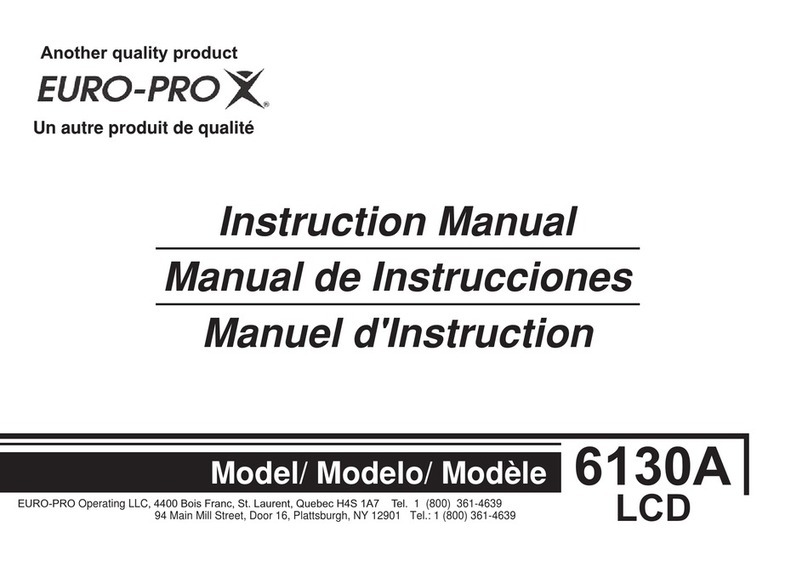
EUROPRO
EUROPRO 6130A User manual
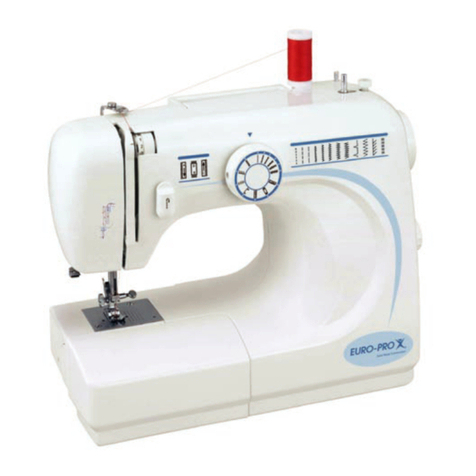
EUROPRO
EUROPRO 385X User manual
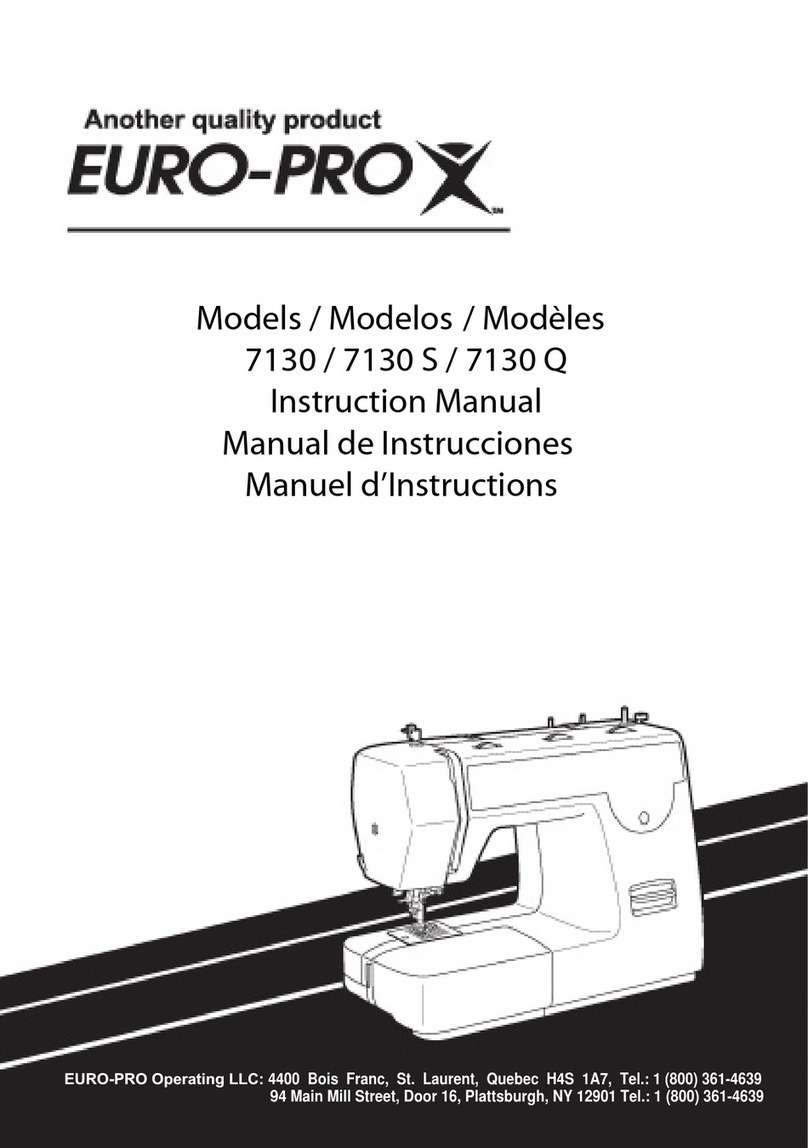
EUROPRO
EUROPRO 7130 User manual
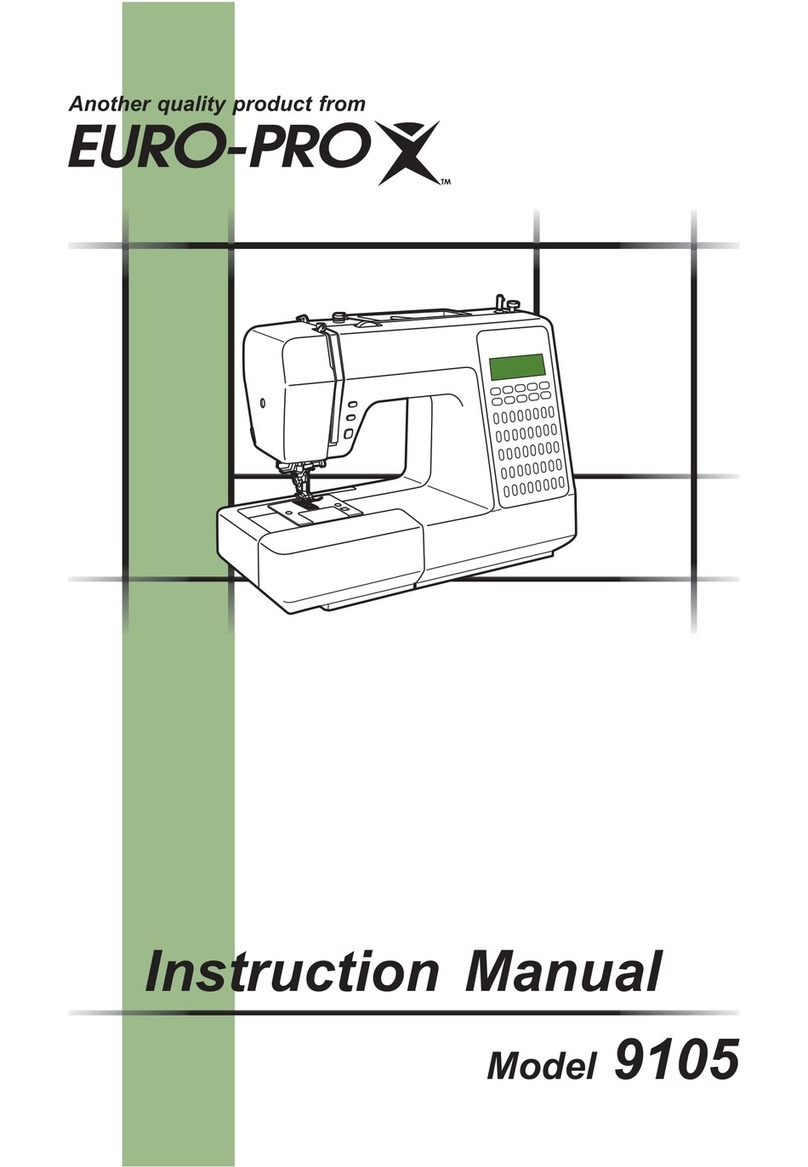
EUROPRO
EUROPRO 9105 User manual
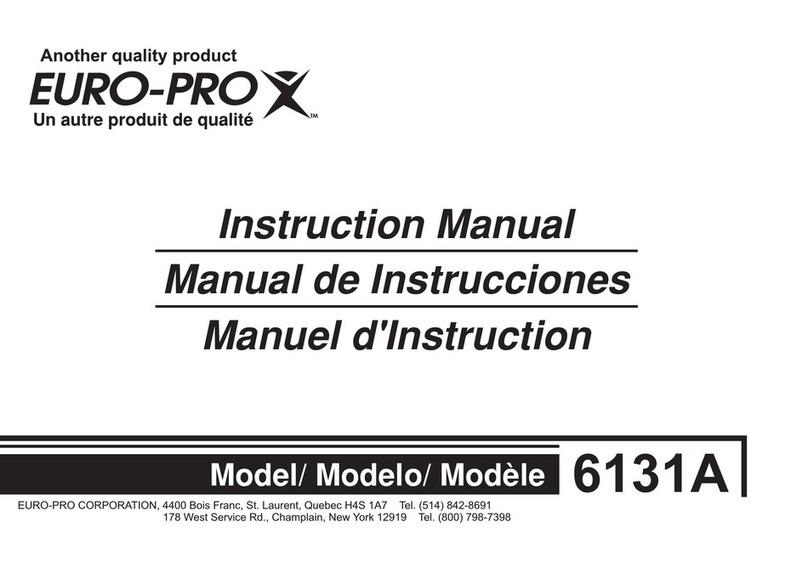
EUROPRO
EUROPRO 6131A User manual

EUROPRO
EUROPRO 464XC User manual

EUROPRO
EUROPRO DRESSMAKER 1104HB User manual
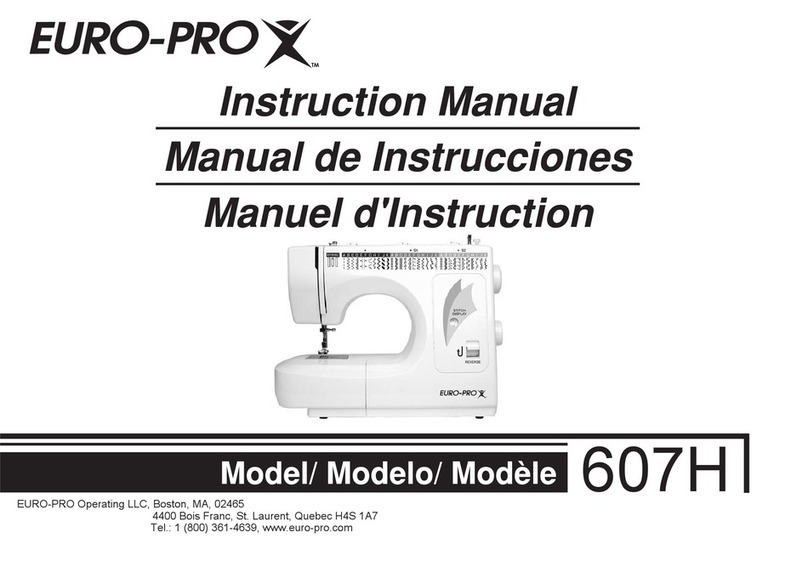
EUROPRO
EUROPRO 607H User manual

EUROPRO
EUROPRO 7100 User manual

EUROPRO
EUROPRO 420 User manual
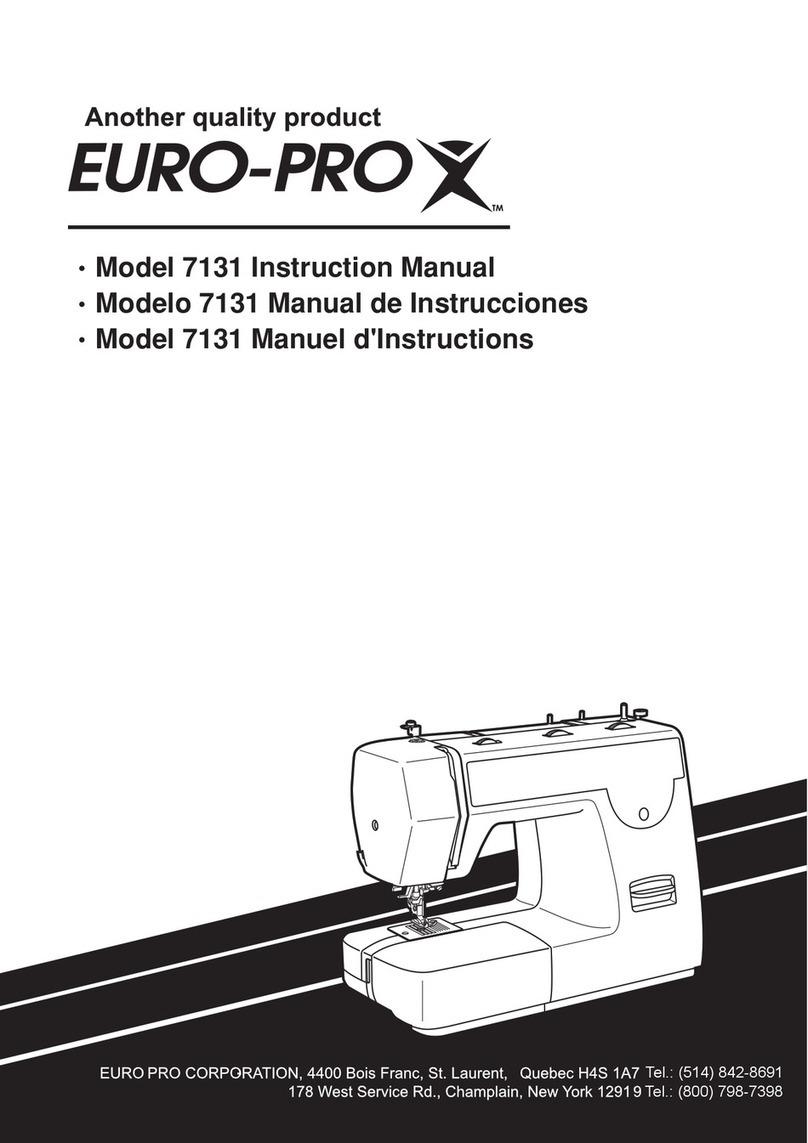
EUROPRO
EUROPRO 7131 User manual
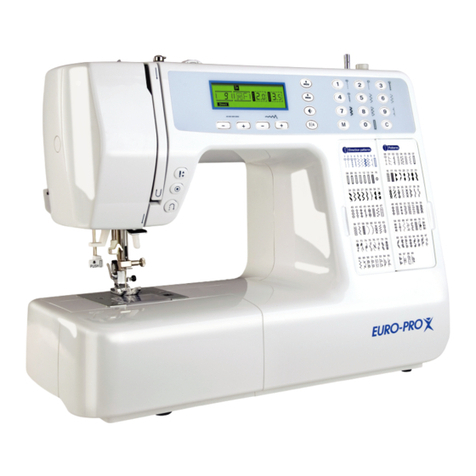
EUROPRO
EUROPRO INTELLI SEW 9136C User manual
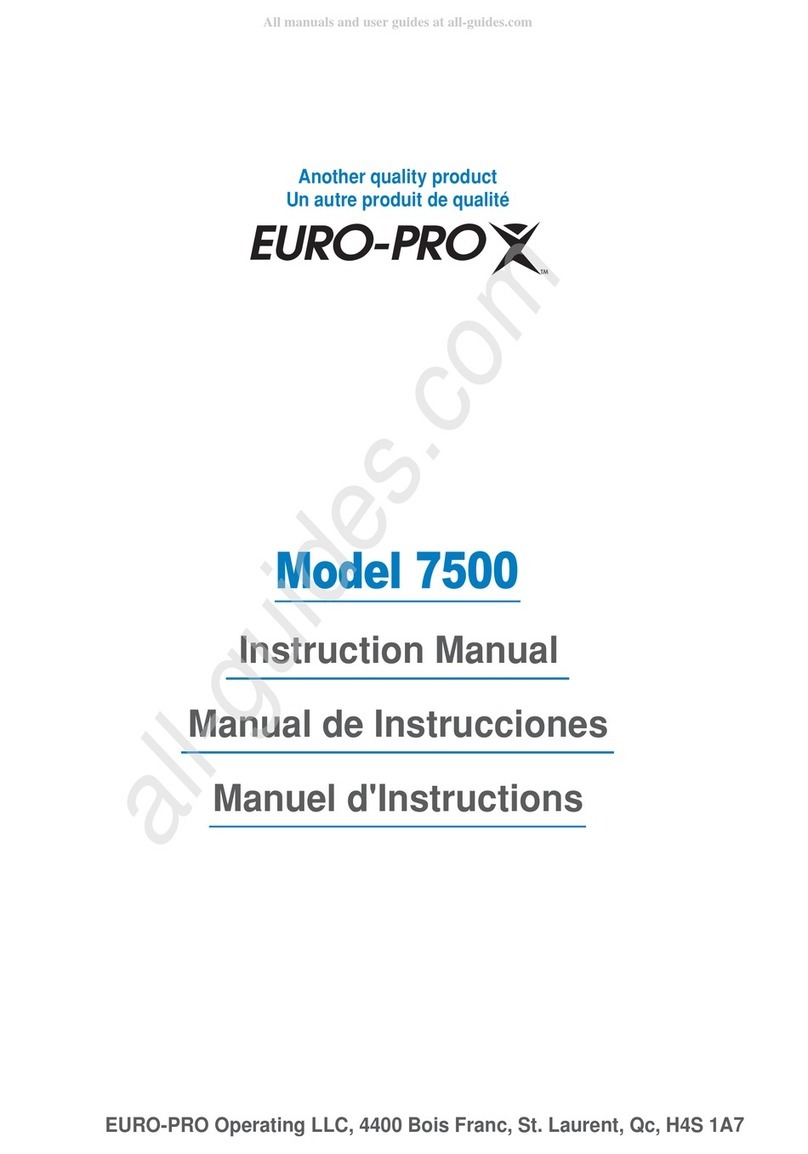
EUROPRO
EUROPRO 7500 User manual
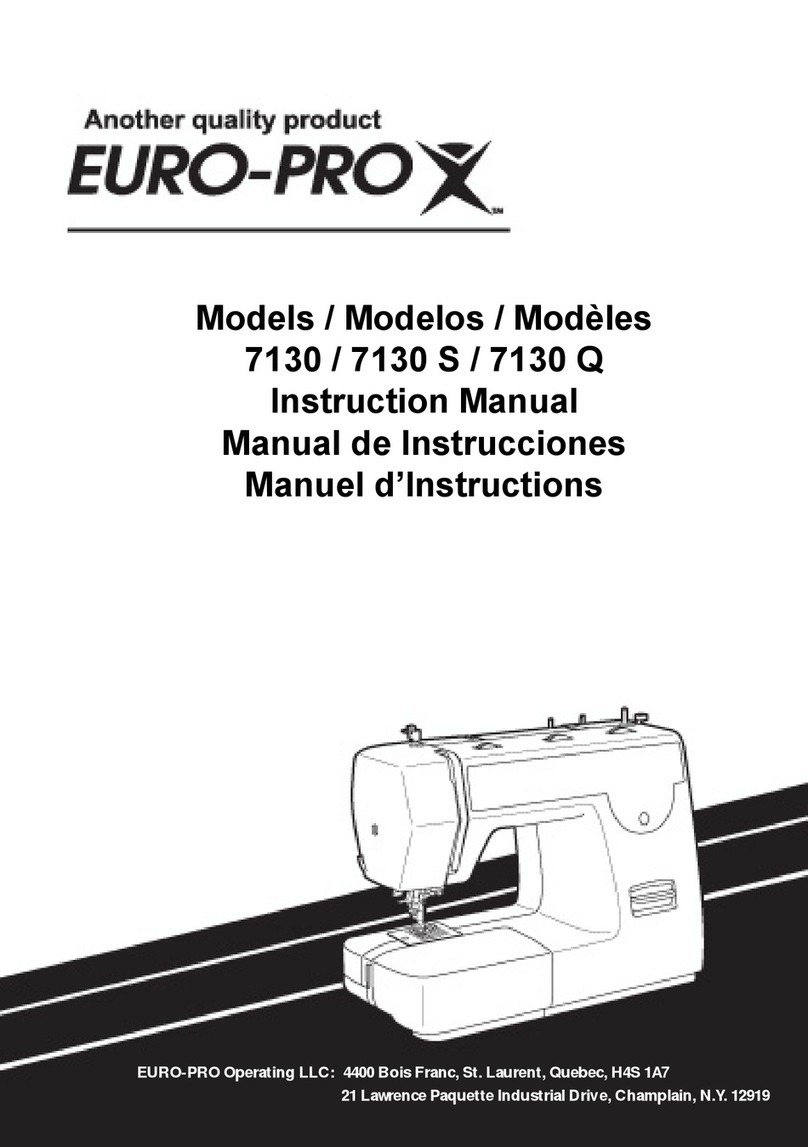
EUROPRO
EUROPRO 7130 S User manual

EUROPRO
EUROPRO 8660 User manual

EUROPRO
EUROPRO Shark 7133 User manual

EUROPRO
EUROPRO Shark 101-548 User manual
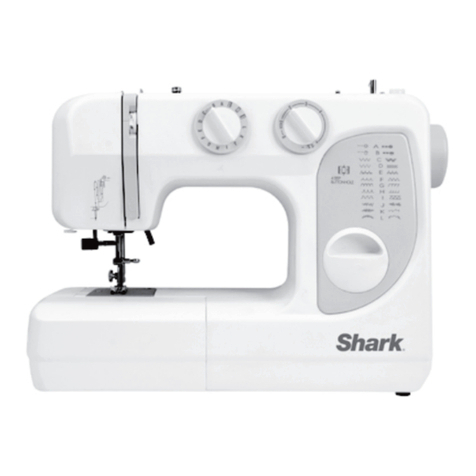
EUROPRO
EUROPRO Shark 803XC User manual
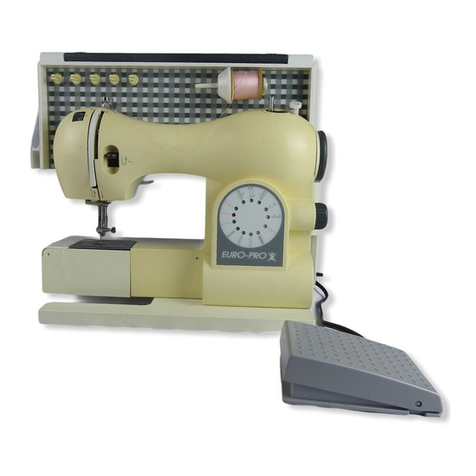
EUROPRO
EUROPRO 416 User manual
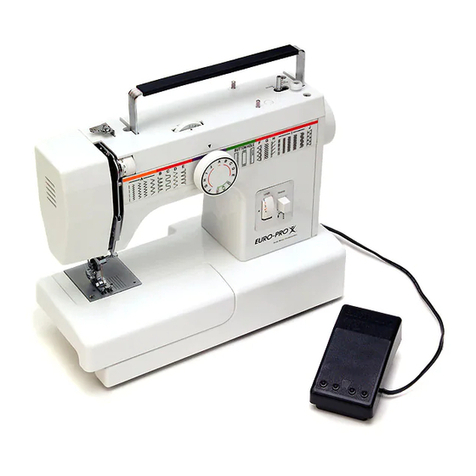
EUROPRO
EUROPRO 380 User manual
